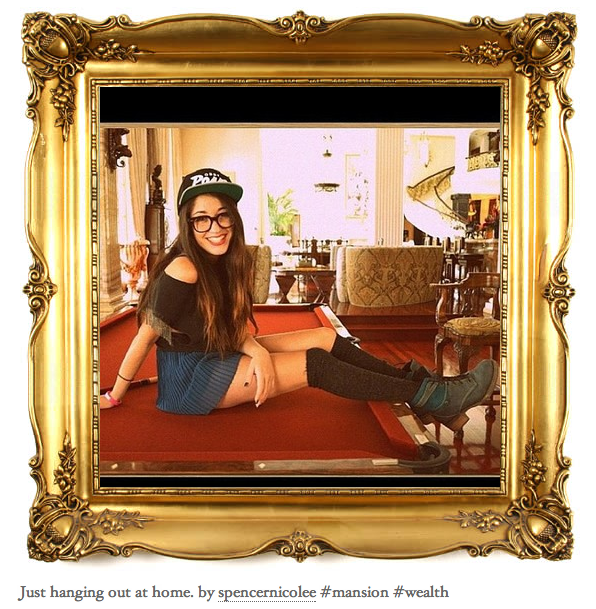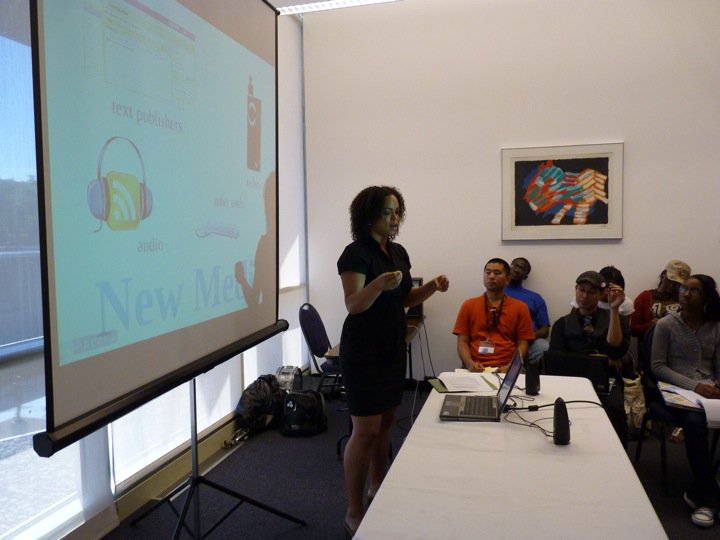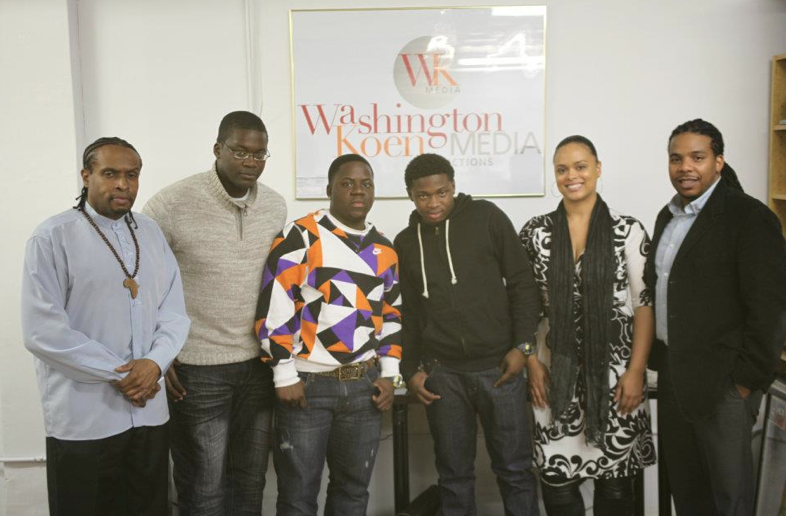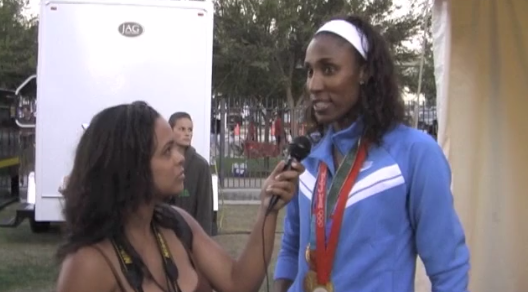Meet MMC's New Youth Correspondent! Zoe Zvosechz
More teens and kids around the world are on the Internet, so why not start there? - Zoë
We're so excited to introduce you to Zoë Zvosechz (pronounced ZO-ee ZA-vose-ICK), MEDIA MAKE CHANGE's brand new youth correspondent!
Zoë, 14-years-old, was born in Germany from a U.S. military family currently living in El Paso, Texas. She loves soccer, writing, and JUSTIN BIEBER! Zoë also enjoys hanging out with her friends. She describes herself as "often online and posting things on my [Facebook] page, ImmaTeen, and talking to the admins." Zoë enjoys being around family and friends, and aspires to work with young people in need of support.
We recently came across Zoë's Facebook page, ImmaTeen, which brings together young people from all around the country to speak out against bullying. ImmaTeen has garnered over 11,000 likes on Facebook and continues to grow in popularity among teens around the country.
Zoë has also produced (yes, produced!) an anti-bullying digital video, Stop the Tears and End the Fears, which features teens holding up signs that reads "victim" as a way to respond to being bullied in and out of school.
Zoë's work is a prime example of how young people are using social and digital media to transgress conformity and transform communities from the inside-out. It was only natural for us to reach out and ask Zoë if she'd like to be MMC's official youth correspondent. She happily accepted, and we're so delighted to feature her voice, insights, and super cool name on Media Speaks!
We recently had a chance to chat with Zoë about her work and about what she hopes to bring to MMC's community. Check out what she had to say below!
First of all, you are a superstar! We're so excited about the work you're doing using social and digital media. You are the co-creator of ImmaTeen, a Facebook group with over 11K "Likes" that offers teens an alternative space to express themselves and also supports young people who have been victims of online and offline bullying. Can you tell us a little bit about how ImmaTeen came about?
Zoë: When I created ImmaTeen, it was just for fun. Many people were just making pages like ImmaTeen, and these pages were getting so many likes. So I thought, "Why not give it a try?" So I did! I added admins to the page to help me get it up and running, and they're all still on the site. One of the admins was seriously bullied so I went on YouTube to watch videos about young teens being bullied. After watching the bullying videos, I wanted to use the likes on ImmaTeen for good use. I wanted to bring bullying awareness to everybody! I posted my video that I have linked on YouTube to ImmaTeen. Those featured in the video are all fans of the page, and they all have been victimized in some way.
How on earth did you manage to cultivate an online community of over 11K teens on Facebook? That's amazing!
Zoë: My friends and "admins" of the site helped me gain Likes on Facebook! The admins are still part of the Facebook page today. I shared the page around Facebook and asked friends to like and to join the conversation.
What do you hope to accomplish with ImmaTeen? Are you using other social networks to expand ImmaTeen's influence?
Zoë: I hope to spread awareness about bullying and just bring a smile to young people's faces. I want to start a program at my school to address bullying, and to continue to just help young people smile. I'm using my Twitter (@ImmaTeenQuotes) and Tumblr accounts to help spread the word about ImmaTeen.
MMC recently featured a piece, "To Live and Die in Social Media" about the Amanda Todd and Felicia Garcia suicide tragedies, what did you think about these tragedies? Is there anything we can learn from them?
Zoë: I almost cried because of what they went through. To kill yourself over bullying? It really hurts. Really bad. We need to stay strong and not give up. Even if Amanda Todd and Felicia Garcia may have given up, we shouldn't.
What can adults and educators do to support and better engage young people who use social and digital media?
Zoë: Adults should have more school assemblies about bullying and start support groups on the Internet. More teens and kids around the world are on the Internet, so why not start there?
What are some ways young people can be proactive in addressing issues confronting youth?
Zoë: We can talk to each other about how we feel. Young people should have a say in what we are confronted with. Take the election for example, we have a say in the political process even though we can't vote. We still can have an opinion and share it with other people our own age.
We're so excited to have you on board as our official youth correspondent and contributing writer! As MMC's new youth correspondent, what topics would you like to explore, write about, and report on?
Zoë: I'm excited too! I'd like to write about current issues that are bothering young people like bullying, self-improvement, and just trying to fit in. Thanks for having me on board!
You can follow Zoë on Twitter @SnowieZoe - and we *so* recommend that you do!
Related:
Post-Hurricane Sandy Online Resources
A parking lot full of yellow cabs is flooded as a result of Hurricane Sandy on Tuesday, Oct. 30, 2012 in Hoboken, NJ. (via Facebook)
Back in 2005, after hurricane Katrina shattered the Gulf Coast, I began monitoring several online networks created and cultivated by what I called women virtual volunteers. Though Twitter and Facebook weren't around back then, women were created blogs, list servs, and newsgroups in efforts to provide relief support for victims and survivors of hurricane Katrina. This was the first time I witnessed people gathering across time and space to pull their resources online after a natural disaster. It's important to note that at the time, the nurture-networks I looked at were also created in response to lack of support from the federal government, namely FEMA.
Seven years after hurricane Katrina, the country has yet again been devastated by a natural disaster in the form of hurricane Sandy. People along the east coast, and parts of the midwest, are currently assessing widespread damage as a result of a massive storm surge lasting several hours.
As we saw during hurricane Katrina, people have taken to social media to help spread the word about damage and to provide resources for victims and survivors of the storm. However, unlike what we saw during Katrina; that is, when social media looked more like Yahoo! news groups and comments sections of blog posts, those directly and indirectly affected by Sandy have taken to popular social networks like Twitter, Facebook, and even Storify to provide the nation with up-to-date information and online resources. And it's not only traditional journalists and reporters creating these spaces, but also everyday citizens with a cell phone and a wifi connection.
In my continuing efforts to monitor online networks post-Sandy, I've put together a (growing) list of resources that I hope folks will find useful as we begin the arduous process of cleaning up after Sandy. If you have more resources to share, please do so below in the comments section. You may also tweet us @mediamakechange
IMAGES AND STORIES FROM THE STORM
ABC 7 Storify Hurricane Sandy: http://storify.com/EyewitnessNews/hurricane-sandy-1
Storify Users Cover #Sandy: http://storify.com/storify/storify-users-cover-sandy
AcuWeather: Sandy Floods New York City: http://storify.com/breakingweather/photos-sandy-floods-new-york-city-new-jersey
Hurricane Sandy Facebook Group: https://www.facebook.com/pages/Hurricane-Sandy/506493399380778?fref=ts
ORGANIZATIONAL SUPPORT
- Red Cross Hurricane app : http://www.redcross.org/mobile-apps/hurricane-app
- List of currently open Red Cross shelters at: http://www.redcross.org/nss/
- Visit the Red Cross web site: http://www.redcross.org or call 1-800-RED CROSS (1-800-733-2767).
- People should also register on the Red Cross Safe and Well website, a secure and easy-to-use online tool that helps families connect during emergencies: http://www.redcross.org/find-help/contact-family/register-safe-listing
@NotifyNYC on Twitter
- People located in NYC can ‘follow NotifyNYC’ on Twitter, and text 40404 to get @NotifyNYC (http://www.twitter.com/notifyNYC) tweets as text messages.
- Google Crisis map that has good information about Hurricane Sandy as well as shelter information: http://google.org/crisismap/sandy-2012
- A secure, user-friendly web portal that consolidates information about federally funded government assistance to disaster victims, including the ability to apply for FEMA benefits directly online: http://www.disasterassistance.gov
State Offices of Emergency Management
- A list of the emergency management offices in all 50 states plus territories: http://www.fema.gov/regional-operations/state-offices-and-agencies-emergency-management
- The Disaster Distress Helpline (DDH) is the first national hotline dedicated to providing year-round disaster crisis counseling. If you or someone you know has been affected by a disaster and needs immediate assistance, please call this multilingual, crisis support service (available 24/7) at (1-800-985-5990) and SMS (text `TalkWithUs' to 66746). Residents in the U.S. and its territories who are experiencing emotional distress related to natural or man-made disasters: http://disasterdistress.samhsa.gov/ toll-free number for information, support, and counseling. You will be connected to the nearest crisis center.
- Also see The Salvation Army's blog with up-to-date information on hurricane Sandy. http://www.salvationarmyusa.org/usn/www_usn_2.nsf
- You can email nycservice@cityhall.nyc.gov for more information on how to volunteer in your area. http://www.nycservice.org
- Be sure to visit their website BEFORE going to donate blood. Not all centers are open because damage due to the storm. We recommend that you call 1-800-933-2566 or visit www.nybloodcenter.org for donor center hours and the latest information. Thank you for your support. http://www.nybc.org/press-release.do?sid0=60&page_id=152&content-id=785
- Delivers medicines, medical supplies and aid to people in crisis around the world. http://www.americares.org/
- Provides medical assistance to people affected by disaster. http://www.directrelief.org/
Sources: Facebook, CraigConnects, Huffington Post
Related Stories: Hurricane Sandy: Red Cross, Other Relief Organizations See Social Media as 'Double-Edged Sword' For Relief Efforts
To Live and Die in Social Media: What We Can Learn From Amanda Todd and Felicia Garcia
On September 7, 2012, Vancouver teen Amanda Todd posted an 8-minute black and white YouTube video, "My story: Struggling, bullying, suicide, self harm" chronicling her struggles with being teased and harassed by fellow classmates. Todd doesn't speak at all throughout the video, and instead holds up placards in front of a webcam. Each piece of paper outlines her story while viewers are provided with a glimpse into Todd's experiences as a victim of cyberbullying, and as according to Naomi Wolf, a victim of adult male cyberstalking. Others have noted that Todd was also victim of slut shaming, or the idea of "shaming and/or attacking a woman or a girl for being sexual, having one or more sexual partners, acknowledging sexual feelings, and/or acting on sexual feelings" (Finally Feminism).
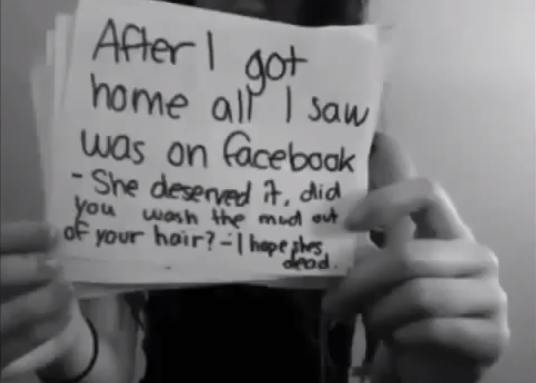
When describing an altercation she had with her classmates at school, Todd writes, "After I got home all I saw was on Facebook - 'She deserved it. Did you wash the mud out of your hair? - I hope she's dead.'"
On October 10, 2012, approximately one month after Todd posted the video on YouTube, she was found dead after an apparent suicide attempt.
On October 24, nearly two weeks after Amanda Todd reportedly committed suicide, Felicia Garcia, a Staten Island teenager jumped in front of a moving train in New York City. Friends and family said Garcia was bullied in school and online because rumors were spreading that she'd been sexually active with football players at her high school. The last words a friend heard Garcia speak right before falling backwards in the path of a moving train were, "Finally, it's here."
Though Garcia's classmates didn't seem to think she was in trouble, a quick glance at Garcia's Instagram pictures tells another story.
Similarly to Todd posting on YouTube, Garcia posted, what I believe to be her last cry for help via Twitter twelve days before she decided to take her own life.
It's heartbreaking to watch our young people take their lives as a result of being bullied by other teens and adults online. As a researcher, I wonder why our young people, girls and boys, decide to use social media as one of the last forms of communication before killing themselves. While it seems like a classic case of cry-for-help, social media further complicates this psychoanalytic narrative by the so-called spectacle in the form of retweets, @ replies, favorites, and likes.
I have to wonder what Amanda and Felicia felt while uploading and posting. What did they really wish to communicate? And has social media now become an alternative to the handwritten suicide letter?
I recently spoke with The Media Bytes about young people in the digital age. I mentioned Amanda Todd in our conversation, in that I believe we failed this young girl in many ways. We had access to knowing and seeing her struggles in a mediated and visible space, yet still we were unable to, or not willing to intervene. During the interview I mentioned that perhaps seeking out social and public spaces while struggling essentially comes down to our basic human need to connect with someone; anyone who will watch our videos and read our tweets.
I understand this need to connect all too well as I also struggled, and was diagnosed with severe depression and post traumatic stress disorder (PTSD) after my father passed away in 2008. I took to singing on Youtube early on while my father was sick. It was a cathartic response to coping with death and dying. It still is. I'm sure if I revisit my Twitter streams, Facebook updates, blog posts, and even SMS text messages during that time immediately after my father's death, I would see myself in my most rawest and vulnerable form. There was something about singing and talking to a camera, then uploading to a public site that allowed me to let go. To where and to whom I let go in this public space was, and is always a risk. But for Amanda and Felicia it was more than simply letting go publicly online, it was a permanent disconnection from a space so-called the 'real' offline world.
Now we are left with YouTube videos, tweets, and Instagram photos that will continue to remind us of our failure as a tribe in the global village.
That said, however, ubiquitous use and mainstream presence of social and mobile media provide a unique opportunity for adults (and anyone else who cares about the well being of young people) to better address youth in crisis. I recognize that the idea of 'crisis' itself carries with it a ton of baggage; what exactly is meant by crisis? Is crisis a word we only use for certain 'kinds' of communities? Is the very idea of wanting to un-do crisis problematic because it automatically assumes something needs to be fixed? And might that 'something' be the child? One look at the comment's section of this post, and the constant victim blaming that ensues, reminds me that we, as a collective, still haven't fully grasped what it means to be empathetic in a crisis situation. So, I recognize the conundrums.
But I also recognize that something unlike anything I've ever witnessed before is happening with our young people in this digital moment. We live in a hypermediated and interconnected world, so much so that we now craft our identities in these public and mediated spaces like corporations do; as brands. We've always created elaborate narratives of ourselves, but now it seems as though these narratives are beginning to take on a posthumous life of their own.
It's fascinating when you think about the posthumous digital life. Yet, I still wonder where do we stand in the midst of this crisis as our young people both live and die in social media?
We simply can't be satisfied with mourning the deaths of these young girls after the fact and behind our computer screens. What keeps us from nurturing our young people while they are alive? What keeps us from engaging them as they explore their multiple and contradictory identities? What keeps us from being more attentive as they express themsevles in these public places---not as a way to police or to monitor inappropriate behaviors---but as a way to gain insight into what's actually happening in their media-rich, public, and interconnected worlds?
Part of what I wish to do as an academic and social entrepreneur is to create spaces where young people like Amanda Todd and Felicia Garcia (who was in foster care) can go to retreat, reconnect, and rebuild. And I believe media and technology can play a transformative role in mediating what I'm calling nurture-networks. But we have to be deliberate and thoughtful in how we further encourage media and technology in the lives of young people, particularly those in crisis.
I recently applied for the Media Ideation Fellowship and my idea is to specifically address the needs and concerns of young people in crisis, namely court-involved youth who are tethered to multiple social institutions like foster care, juvenile, and welfare systems. I'm hoping to create a localized SMS Texline co-developed by and serving the needs of court-inolved youth in New York City. While I understand that media and technology is not *the* answer to address ongoing and dynamic problems young people face in today's world, I do believe that media and tech tools can help to support deliberate efforts in (re)building what's seemingly been broken. As evident with Amanda Todd and Felecia Garcia, our young people are living and dying in these social and mediated spaces, isn't it about time we meet them where they already are?
**Update***
I just discovered that Amanda Todd sang too.
The Need to Educate the Rich Kids of Instagram
From My MEDIAted Life
There is a new Tumblr page that has been getting quite a bit of attention in the last few weeks. It's got an unoriginal, yet strangely catchy title that would cause almost anyone to click on the link: Rich Kids of Instagram. Your finger might hover over the mousepad for a moment--sure that it could not possibly be what the straight-forward label is seeming to describe, yet weary that it most likely is--you wonder if this is what you should be doing with your time? Should you throw a load of laundry in before you make this time commitment for something you might later regret, or worse, that you might absolutely love (but not be able to tell anybody about)? But like so many other viral videos and Internet memes, in which a mere click stands between you andknowing what everyone else is talking about, this site wins over any rational thought, and just like that you feel the pad of your index finger make contact with the cool sensory surface beneath it.
As soon as the URL loads and the site opens, you dive face-first into a scrolling cluster of photographs and hashtags. The images have all presumably been taken by smartphones (most likely iPhones) and have been enhanced through an application called Instagram, which adds different filters to digital pictures and allows them to be uploaded to various social networking platforms (i.e., Facebook, Twitter, Tumblr, etc.) instantly and seamlessly. The subtitle of the site is "They have more than you and this is what they do," and the hashtag is #rkoi. The images are first uploaded by the young people who snapped the shots to the RKOI's Twitter account and are then fed onto the Tumblr page for easy viewing.
The pictures are displayed in gold frames, suggesting that they are pieces of fine art and conveying an obvious and assumed air of wealth, high culture, and importance. Below each image we find numerous hashtags that the artists have used to 'describe' their masterpieces: #mansion, #wealth, #yacht, #personalchef, #cartier, #NBD (no big deal). The seemingly endless collection of photographs are obnoxious, yet every time I visit the site I find myself clicking from page to page, thirsty for more, even if I've seen the same images four or fives times at this point. What is going on?!As hard as I try to maintain that I am fascinated by this warped website solely for critically analytical and research-related purposes (I'm making a very serious face while saying this), the reality is that I have been 'trained'--socialized and normalized--for decades now to associate the types of images and messages depicted on this site with notions of what "happiness", "success", "popularity", etc. look like; what they mean. If I am having these reactions as a 28-year-old, we must seriously consider how teens might be viewing this site and think about the kinds of conversations that we as educators, adults, parents, can have with the young adults in our lives.
1. The subtle effects and implications of the gold-frame template:
While viewers might feel as if they've become numb to composition after streaming through dozens of images, there is an undeniable novelty and uniqueness in seeing photographs, not oil paintings, housed in these garish golden frames. Instead of invoking a simulated feeling that we are strolling through the quiet rooms of art gallery or museum--observing these masterpieces interspersed on stark white walls--the juxtaposition of the bold, saturated, filtered photographs with the chunky golden frames instead creates a feeling of voyeurism among viewers. We are outsiders being granted access to certain snapshots, postage-stamp views, of what life in the 1% is like.
What might this voyeurism mean for both the creators and consumers of these images? There is an extreme sense of excitement on both ends: for the creators of these media images and messages--they are sharing their lived experiences and material possessions with their peers (and now with wider audiences). Hell, at 14-, 17-, even at 25-years-old (especially in the age of social media and social networking sites), there is a certain undeniable, almost unavoidable [I said almost] narcissism that runs rampant in users' status updates, photos, etc. It's the nature of the beast, but it doesn't make it ok, or mean that we simply and passively accept that this is just how people can and should act as a result. We still must consider, now more than ever, what effects these displays of wealth, materialism, lifestyle and activities might have on the "99%" who have been socialized to perhaps think this representation is 'covetable', on the "1%" who think this representation is "normal." And what it really comes down to is that we should really be taking into account the possible effects that these representations are having on100% of today's youth. Virtually almost (again, almost) every young person in the US is exposed to and interacts with some sort of media on a daily basis--using a cell phone, playing a video game, surfing the Web, or watching television. Today's youth are growing up in an increasingly media-saturated culture and we have a responsibility to help them learn how to successfully navigate their lives through the unprecedented products, behaviors, and activities now being "the norm" in the 21st century.
2. Understanding digital footprints & increasing awareness about digital citizenship:
On August 10, 2012, an article was published on the Bloomberg Businessweek website entitled, "The Very Real Perils of Rich Kids on Social Networks". The article provides an account of how some recent online activities of Alexa and Zachary Dell, daughter and son of Michael Dell (of Dell computers), got them their 15 minutes of Internet fame as well as a terminated Twitter account after Alexa posted a photo of her brother in their private jet, heading to Fiji on RKOI. It was later discovered that this was just one of numerous photographs and statuses containing personal information about her family's whereabouts and activities that she'd posted over the last few months. Mr. Dell pays almost $3 million a year for security protection of his family, so needless to say, this breach of security from an insider was probably both alarming and upsetting. This article provides a powerful illustration and example not only of how quickly information spreads via new media platforms like Twitter and Facebook, but more importantly how easily this information can directly challenge others' efforts of enforcing tangible security measures. In addition, and most importantly, this article serves as an excellent example of the lack of awareness and/or regard that young people tend to have for the often permanent digital footprints that they create as a result of their online activities, particularly on social networking sites. And while some may argue that there are greater implications when the rich (and not necessarily famous) upload pictures of everything from party invitations with the date, time, and location to license plate numbers (all of which can easily and automatically be geo-tagged) to the Twittersphere, the reality is that this online behavior/activity of constantly over-sharing details about their lives can have very real consequences, regardless of one's social class. In a recent New York Times article on the recent upsurge of 20-somethings sharing TMI (too much information) in the workplace, Peggy Klaus, an author and executive coach of corporate training programs explains,
Social media have made it the norm to tell everybody everything...MANY people blame narcissistic baby-boomer parents for raising children with an overblown sense of worth, who believe that everything they say or think should be shared. When I told a British colleague that many Americans were starting to realize that they reveal way too much about themselves, he gave a full-throated laugh and said, “Finally!”
While our first instinct may be to want to protect youth, the takeaway here is not that we need to shield young people from the media tools and content that might cause them to engage in risky activities and behaviors. Instead, we should regard the situation with the Dell children and the realities of the millennial generation outlined by Klaus as important illustrative examples of the fast-forward-moving trajectory that our society and culture is travelling on. As educators, parents, and adults in the 21st century, we have an opportunity and obligation to use these examples to engage the youth in our lives in conversations about digital citizenship, which can include topics of online safety and privacy, cyberbullying, and copyright fair use of online information; media literacy, understanding how and why media messages are constructed and how they can influence beliefs and behaviors; and digital literacy, how to read and evaluate information online.
Use the images on RKOI to ask youth about who they think the image is intended for, what attracts their attention, what lifestyles and behaviors are represented, how different people might interpret the images and messages differently, and what they think may have been left out of the image and why? A conversation about the composition of both the photographs and the website itself—having students think critically about representation, communication, and production—could be integrated into an English lesson on writing about and showing one’s lived experiences through words and images; a social studies lesson on the powerful images and messages from the Civil Rights Movement, juxtaposing them with the very different content displayed on RKOI (in which case, it would also be crucial and a unique way to address issues of race, gender, and class as they relate to both sets of images and messages); or a computers and technology lesson focusing on the dos and don’ts of web-design.
The bottom line is that we must have conversations, many multi-layered conversations, with each other and with youth about sites like RKOI: about the activities and lifestyles represented, as well as the online and offline behaviors fueling the creation of and participation in such sites. It is ok and very normal to want to protect our youth from the unknown, but we’re doing ourselves and them a disservice if we think that leaving these unprecedented realities unaddressed is better than sinking our teeth into them in order to proactively figure all of this out, and we need to do it together--parents and children, teachers and students, peers to peers, or else we're never going to get anywhere.
Emily Bailin is a doctoral student at Teachers College, Columbia University. She's also an an educator, consultant, and public speaker motivated by a passion and determination to collaborate, create, and sustain culturally relevant and socially just pedagogy with other educators to better serve increasingly diverse 21st century learners. You can follow her on Twitter at @emilybailin
Nominate Tara L. Conley for 2012 Media Ideation Fellowship
Dear family and friends,
I’m writing to you directly for your support in nominating me for the 2012 Media Ideation Fellow (Graduate Level).
The Media Ideation FellowshipSM is an investment in a new generation of social entrepreneurs. Fellows will receive financial resources and mentoring to help bring an early stage idea to life. The Media Ideation FellowshipSM is an opportunity for young innovators to test assumptions, research target audiences, and build strong business plans.
The Media Ideation FellowshipSM is designed to further progressive, social justice-oriented causes. Ideal applicants will have a specific issue or challenge they are looking to address over the course of their fellowship. Projects can be broad in scope, or a simple tool that will help resolve a social inequity or lead to progressive social change.
Why Media Ideation Fellow?
As a Media Ideation Fellow, I will receive a three-month fellowship with a $12,000 stipend and support from mentors in the fields of media and technology.
As some of you may know, since 2010, I’ve dedicated my time and energy to build MEDIA MAKE CHANGE’s brand as best as only one woman could while living in a shoebox apartment located in Harlem, New York. I'm happy to report that as of this summer, MEDIA MAKE CHANGE is officially an LLC in the State of New York. I now seek additional mentorship and financial support to expand MEDIA MAKE CHANGE into the world’s leading incubator for media and technology innovation, ideas, and perspectives for social good.
Specifically, I want to extend MMC's online and mobile platform by building an interactive Call-to-Action Challenge portal (CTAC) that will enable mediamakers, programmers, and designers to submit original ideas and projects that can transform communities and civic engagement practices.
Think: Tech Challenge meets Media That Matters meets Kickstarter.
MEDIA MAKE CHANGE will issue various challenges and calls to action throughout the year so that innovators will have the opportunity to submit their ideas and projects via the CTAC portal, where the public can also make monetary donations.
Challenge prompts might look like the following:
- Submit an idea to create a web or mobile platform that will help voters in your neighborhood locate voting polls on election night.
- Submit an idea to create a web or mobile platform that can help organize constituants to support or protest against a policy-based issue.
- Submit an idea to create an animated short that will inform people about proper recycling practices in your community.
- Submit an idea to create a web series that will explore the lives of women and girl gamers.
- Submit an idea to create a web or mobile platform that will monitor street harassment and bullying in your neighborhood.
- Submit an idea for a digital documentary that explores an issue or perspecitve in the LGBTIQ community.
- Submit an idea for a robot that can assist elderly individuals with daily tasks.
- Submit an idea for a mobile or web platform that can help victims and survivors of environmental catastrophes locate family members, pets, and/or food supplies.
- Submit an idea to create a web or mobile platform that can aid victims of domestic violence and sexual assault.
- Submit an idea to create a digital documentary that explores colorism across various racial and ethnic communities.
The list goes on.
Innovators can set their own funding goals, and successfully funded projects will receive all donations (minus fees).
Unlike established crowdfunding platforms on the web, MEDIA MAKE CHANGE will create specific challenges for media and tech innovators to explore and submit their ideas to. Don't expect to see projects that will fund tech start-ups or music albums. Instead, MMC's CTAC portal is specific in its challenge prompts, content, and design. Only media platforms, projects, and tech gadgets/apps will apply.
My Herstory
I've spent the last 10 years of my life working and playing as a writer, educator, and mediamaker. Over the past decade, I've had the opportunity to work with well established progressive organizations, and learned a great deal about the power of digital media (in all forms) and technology to support causes and promote democracy.
Currently, as a doctoral student studying technology in education, I'm now learning about the importance of computer programming technologies in shaping an entire generation of girls, youth of color, and immigrant learners.
I'm proud to have founded a company that highlights issues relating to media education and technology innovation in efforts to help support communities, confront social injustices, and impact technology policy.
Over the past two years, MEDIA MAKE CHANGE has already established a proven track record in multimedia development by helping to produce the Beyond the Bricks media literacy curriculum and create new media and digital video campaigns for the Schott Foundation for Public Education.
MMC’s blog Media Speaks! has featured original, insightful, and critical content in the area of media literacy, advocacy, and technology innovation.
In the summer of 2012, MEDIA MAKE CHANGE facilitated an online cross-cultural dialogue with In Conversation, a monthly feature that highlighted women of color programmers and mediamakers. Additionally, MMC led a nationwide social media and digital storytelling campaign with #RememberKatrina to bring awareness to environmental and social issues facing citizens living in Louisiana and surrounding states. MMC is also currently working with social entrepreneurs to produce successful crowdfunding campaigns.
Looking ahead, I want to solidify MEDIA MAKE CHANGE’s place in digita media and social justice history by incorporating a dynamic interactive platform that will inspire people to use media and technology to change their communities for the better.
As a Media Ideation Fellow, I will be able to take change agency to the masses with the help of mentorship and financial assistance.
With the support of the Media Ideation Fellowship, I will be able to:
- research established crowdfuding, educational technology, media education, and progressive online platforms
- develop proposals and business plans for potential investors
- gather a team of official MEDIA MAKE CHANGE mediamakers and content producers
- design and develop MMC’s interactive Call-to-Action Challenge (CTAC) portal
The fellowship will afford me the time to conduct research and produce work that will reflect an expansion of MEDIA MAKE CHANGE's brand and mission towards interactivity and civic/community engagement.
In order to accomplish this and more, I’m asking for your nomination for the 2012 inaugural Media Ideation Fellowship.
How to nominate me
You can support by simply going to http://mediaideation.org/nominate/ and filling out the information provided below:
- My name: Tara Conley
- My email: tara@mediamakechange.org
- Check the box for “Graduate Level” fellowship.
I sincerely appreciate your love and support.
Tara









